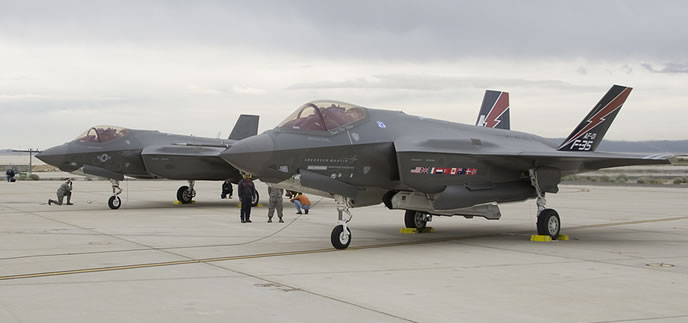Above: F-35 AF-1 and AF-2 Arrived at Edwards Air Force Base in May 2010. The F-35A (CTOL) variant is 66 flights ahead of the planned flight testing this year. Last month AF-2 performed the 300th flight flying on a 2.05 hour mission from Edwards AFB. Below, F-35B performs a vertical landing. Photos: Lockheed Martin

With more aircraft joining the combined test force, the F-35 flight testing program gained momentum and, compared to the delays of past years, is now exceeding schedule. Overall, the program has completed 321 flights this year, and is working toward the total of 394 test flight for 2010. The program has logged 460 flights by early November 2010. Particularly impressive is the status of the Conventional Takeoff and Landing (CTOL) variant and the carrier variant (CV). The Short Takeoff and Vertical Landing (STOVL) variant F-35B is still behind schedule.
Unfortunately, a significant issue recently uncovered with the F-35B STOVL type are cracks developing in the rear bulkhead. Cracks developed on an F-35B ground test plane undergoing fatigue testing after the plane had been subjected to stresses equivalent to about 1,500 hours of flight time. This level is significantly short of the 8,000 hour fatigue limit these structures are designed to withstand.
Among the recent achievements recorded recently were supersonic flight at Mach 1.3 has recorded by the F-35B, this variant also achieved 7 g’s, the highest load condition to date and maximum design g’s for the STOVL.
Another ‘first’ recorded with the F-35B was the delivery of the fourth pre-production aircraft (BF-4), the first ‘Lightning II’ equipped with the ‘Block 1’ avionic software, enabling most of the primary sensors on the F-35. This software forms the foundation of all subsequent software blocks for the F-35. It enables information fusion from the F-35’s radar, electronic warfare system, Distributed Aperture System, electro-optical targeting system and other sensors, and provides initial weapons-release capability. Prior to the integration in the F-35 the new software has flown for several months on the Cooperative Avionics Test Bed (CAT-bird), the airborne integration lab flying in a modified Boeing 737, simulating the new fighter plane.
The delays in development and testing have increased the cost of the aircraft. In an effort to control the escalating cost the Pentagon negotiated a shift from previous cost-plus-incentive fee which was optimized for the development phase, into price incentive scheme, challenging the manufacturer with more responsibility of cost controll. Lockheed Martin has agreed to modify the current low rate initial production Lot IV aircraft contract to a fixed-price-incentive (firm target). Under the new arrangement, Lockheed and the Pentagon share on a 50-50 basis all overruns topping the F-35’s “target price.” Lockheed would be required to absorb the entire overrun once the price exceeds an upper-limit “ceiling.”
The Pentagon announced Nov. 19, 2010 the awarded about $3.5 billion modification covering the procurement of 31 aircraft. This contract represents an average cost of $105-109 million, slightly above Pentagon estimated rate, this amount allocates the necessary funding for flight testing, and other developmental activities. The current lot includes 10 conventional take-off and landing aircraft for the U.S. Air Force (31.6% of the cost); 16 short take-off vertical landing (STOVL) aircraft for the U.S. Marine Corps (48.4%); one STOVL aircraft for the United Kingdom Royal Navy (3.4%); and four carrier variant aircraft for the U.S. Navy (16.6%).
Parallel to this progress, F-35 is also gathering momentum in the world market. Japan is likely to consider the aircraft in favor of the development of an indigenous 5th generation fighter. The U.S. administration is moving to clear the sale of a second squadron of 20 F-35s aircraft to Israel, given an agreement from Jerusalem for foreign policy concessions demanded by the White House. Lockheed Martin is also hopeful that the U.S. administration will approve its request to offer the F-35B or F-35C carrier version to India, replacing the Indian Navy fleet of Sea Harrier. India had already floated a request for information (RFI) for a carrier based fighter plane earlier this year. India is planning to launch several new aircraft carriers through the decade. For the near term, MiG-29K was selected as the principal naval aviation fighter aircraft.


















